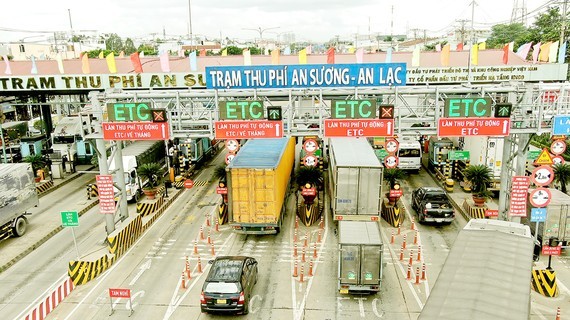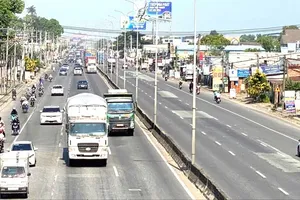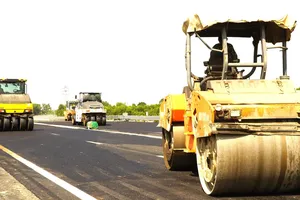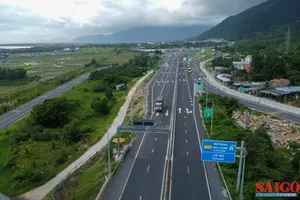
Phi Hoang, an automobile driver in HCMC, shared that he has just come back from a trip to Binh Phuoc Province. On his way, he witnessed the staff in 8 ETC booths manually scan the cards installed on vehicles or enter vehicle license plates into the system for toll charging. Even though Hoang’s traffic account was positive, the system still announced that it was negative. He was directed to move aside to pay cash directly, but was then informed that the toll had already been deducted from his account.
“The ETC lane in the toll plaza at Phu My Bridge is now manually automatic”, said driver Vu Tuan sarcastically. More seriously, T. Nguyen in HCMC shared that while he was driving his car in District 11, he was informed that a toll fee was deducted from his traffic account when passing Phu My Bridge Toll Plaza. Greatly annoyed, he had to call the hotline to report the unacceptable issue.
The HCMC Transport Department informed that from August 1-30, there were nearly 3.4 million vehicles passing the three toll plazas in the city, namely An Suong – An Lac, Hanoi Highway, and Phu My Bridge. About 82 percent of them used the ETC lane. However, the rates of failure in card reading in these plazas saw a soaring to 5 percent (An Suong – An Lac Toll Plaza) and 10.2 percent (Phu My Bridge Toll Plaza).
The majority of these failures happens with the cards of VDTC, which is controlling 35 ETC booths out of 145 booths nationwide.
Until now, the Transport Ministry has only permitted Vietnam Electronic Toll Collection Co. Ltd (VETC) with its e-Tag and Vietnam Digital Transport JSC. (VDTC) with its ePass to operate ETC systems. BOT (Build-Operate-Transfer) investors can directly install camera systems, signal receivers, transmission lines, and automatic barriers, but the information processing, fee collection, and information checking are done on the platforms of VETC or VDTC.
The Transport Ministry shared that there is no report on this matter yet. All the cards are imported from leading international companies like SSI in Thailand, Neology in the US and satisfy the standards set forth by this ministry.
However, Director of Vietnam Urban And Industrial Zone Development Investment Corporation (IDICO) affirmed that the failures are mostly due to damaged, dirty, or low-quality cards, as well as wrongly installed cards on vehicles. He said that it is impossible to blame card reading machines since a failure on such machines happens in the whole system, not to a single booth.
Deputy General Director of VETC Ho Trong Vinh shared admitted that only in a short time, VETC tried to install over 1 million cards on vehicles. The staff shortage might lead to mistakes in this process. Also, some drivers purposely peeled off ETC cards on this vehicle to paste onto another one, leading to damages to the electronic circuit on the card.
 The ETC card installed on a vehicle is damaged, and the car cannot pass the ETC booth. VETC employees then had to help the customer to re-install the card. (Photo: SGGP)
The ETC card installed on a vehicle is damaged, and the car cannot pass the ETC booth. VETC employees then had to help the customer to re-install the card. (Photo: SGGP)
Many drivers voiced that the card installation fee of VND120,000 (US$5.1) is unreasonably high. VDTC explained that according to Decision No.19/2020/QD-TTg, vehicle owners have to pay an installation fee to ETC service providers, including the costs of card importation, goods shipping, card reader, staff for card installation and customer service, media. This is rather illogical since the service provider must also share these expenses.
VDTC is now asking its employees to pinpoint the exact reasons of card reading failure to address the issue. It will help customers to put the card at the optimal location on their vehicles. It will monitor the operation of the ETC system more closely to ensure stability. The last task is to improve the capacity of its customer support staff.
The Transport Ministry has asked the localities where ETC booths are sited to work with service providers to timely tackle any card reading problems. The Directorate for Roads of Vietnam is commanded to strictly supervise the technical quality of ETC services in order to address any subjective faults. The service providers are requested to increase their staff to help customers in this first stage of running ETC systems.
More importantly, this ministry will consider sanctions for specific violations of either vehicle drivers or service providers to improve the situation.
As to the ways to pay tolls when passing an ETC booth, Vietnam now cannot carry out post-paid methods due to existing problems in the payment process between service providers, BOT investors and banks. In particular, it takes 30 days to complete a post-paid cycle. This delay leads to the renegotiation of all credit contracts for the project. Drivers’ extreme lateness in toll payment will affect the capital recovery process of both investors and banks.
As planned, in the first stage, toll booths still use a barrier, which will lift up for vehicles with a valid ETC card and positive traffic account to pass. In the second stage (From 2024-2025), there will be no such barriers or toll booths, but only lane separators.
However, Deputy General Director of VETC Ho Trong Vinh commented that when there is no more barrier, a vehicle with a negative traffic account or with no ETC card can also pass the toll plaza, and the service provider has no way to recover this debt. Therefore, he proposed that state agencies must develop a suitable legal corridor and clear sanctions for such violations. Also, only when the proportion of vehicles with an ETC card reaches over 95 percent can these barriers be removed.
























